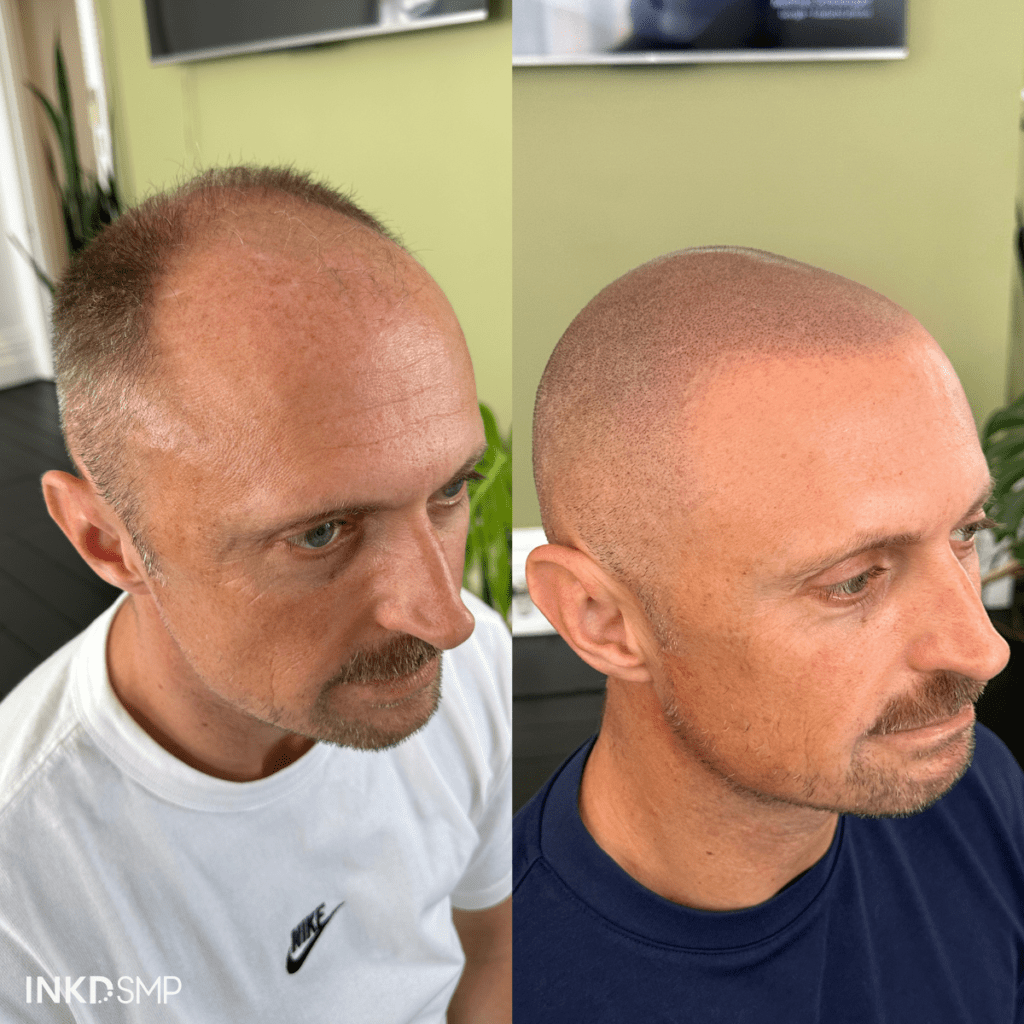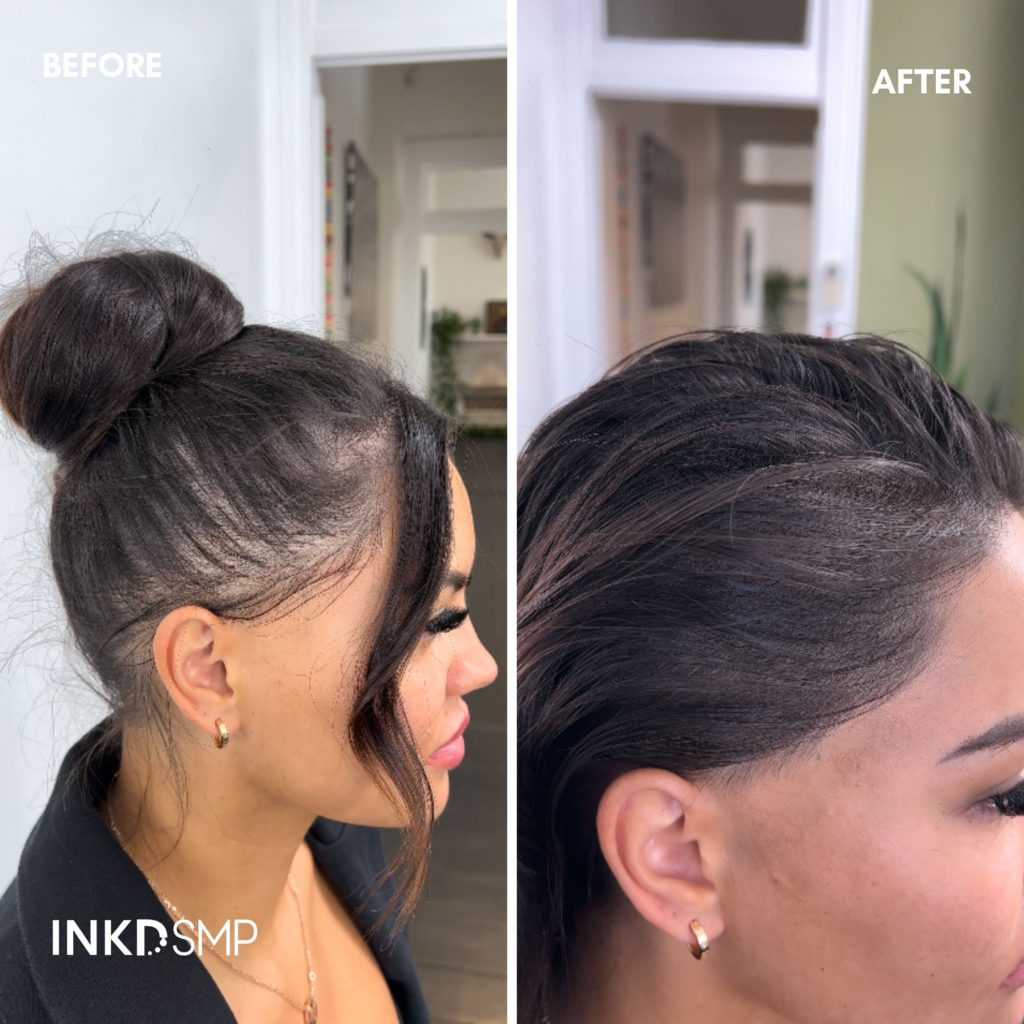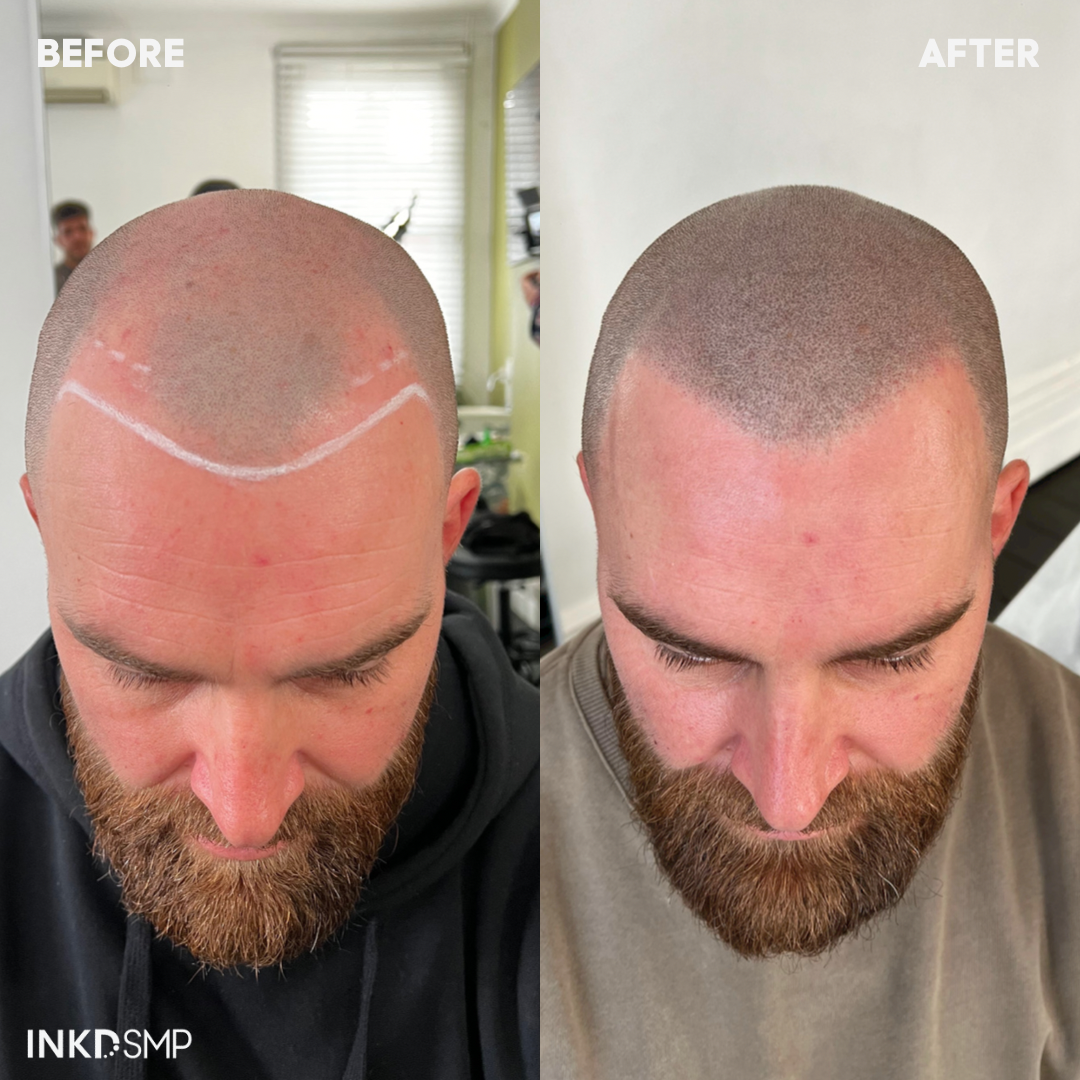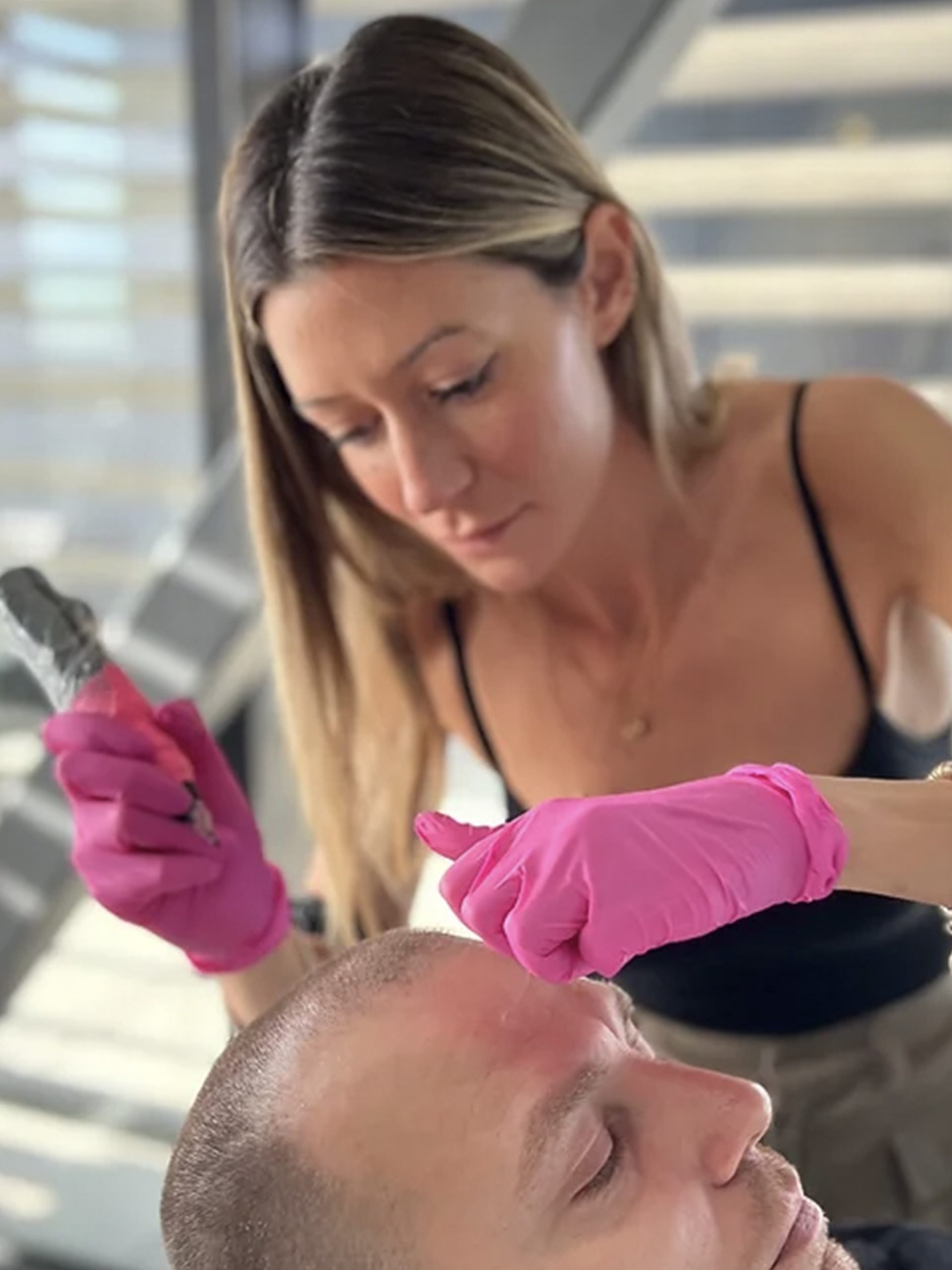Unveiling the Process: How does Scalp Micropigmentation work?

Overview
Are you curious about scalp micropigmentation and how it can help address hair loss concerns? Scalp micropigmentation (SMP) is an innovative technique that has gained popularity as a non-invasive solution for individuals experiencing hair thinning or baldness. In this article, we will delve into the fascinating world of SMP, exploring its benefits, procedure, aftercare, and more. So, let’s unravel the science behind scalp micropigmentation and answer the question: What is SMP and how does scalp micropigmentation work?
Scalp Micropigmentation: The Art of Creating Natural-Looking Hairlines and thicker hair
Scalp micropigmentation is an advanced cosmetic procedure that involves depositing tiny pigment dots into the scalp using specialised equipment. These dots replicate the appearance of hair follicles, creating the illusion of a fuller head of hair. Skilled practitioners strategically apply the pigments, matching the colour and density of your natural hair, resulting in a realistic and natural-looking hairline. The process is meticulous, and the results can be truly transformative, boosting confidence and self-esteem.

Who Can Benefit from Scalp Micropigmentation? Unlocking the Ideal Candidates
Scalp micropigmentation is a versatile solution that offers numerous benefits to a wide range of individuals. Scalp micropigmentation benefits both men and women experiencing various stages of hair loss, including conditions such as
- Male pattern baldness
- Receding hairlines and baldness at the crown of the head
- Alopecia
- Hair loss in women
- Chemotherapy-related hair loss
- Hormonal conditions like polycystic ovary syndrome (PCOS)
- Scars from previous hair transplant surgeries or accidents

The scalp micropigmentation procedure typically consists of multiple sessions, spaced a few weeks apart. Each session lasts a few hours, depending on the extent of the treatment. The process involves meticulously injecting the pigments into the scalp using a specialised microneedle or tattoo gun. The practitioner carefully evaluates the direction, angle, and pattern of natural hair growth to achieve a seamless and natural-looking result. The number of sessions required varies depending on individual factors, such as the desired hair density and the extent of hair loss.
Inside the Process: A Step-by-Step Guide to Scalp Micropigmentation
The scalp micropigmentation procedure typically consists of multiple sessions, spaced a few weeks apart. Each session lasts a few hours, depending on the extent of the treatment. The process involves meticulously injecting the pigments into the scalp using a specialised micro-needle. The practitioner carefully evaluates the direction, angle, and pattern of natural hair growth to achieve a seamless and natural-looking result. The number of sessions required varies depending on individual factors, such as the desired hair density and the extent of hair loss.
Post-Treatment Care: Nurturing Your Scalp after Scalp Micropigmentation
Scalp micropigmentation offers numerous advantages for individuals seeking a solution to hair loss. Some of the key benefits include:
Instant Results: Unlike hair transplant procedures, which require time for hair to grow, scalp micropigmentation provides immediate results. As soon as the procedure is complete, you can enjoy the appearance of a fuller head of hair.
- Non-Invasive: SMP does not involve surgery or the use of chemicals, making it a safe and non-invasive alternative to other hair restoration methods.
- Low Maintenance: Once the pigments have settled, scalp micropigmentation requires minimal maintenance. You can enjoy the look of a full head of hair without the need for daily styling or expensive hair products.
- Long-Lasting Results: With proper care, scalp micropigmentation can maintain its appearance for several years, providing a long-lasting solution for hair loss concerns.
While scalp micropigmentation is generally considered safe, like any cosmetic procedure, it does carry some potential risks. These risks include allergic reactions to the pigments, infection, and skin irritation. However, by choosing a reputable practitioner and following proper aftercare guidelines, the likelihood of experiencing complications is significantly reduced.
Who Should Avoid Scalp Micropigmentation? Examining the Considerations
While scalp micropigmentation is a suitable option for many individuals, certain considerations may make it unsuitable for others. Individuals with certain skin conditions, such as psoriasis or eczema, may need to consult with a dermatologist before undergoing SMP. Additionally, individuals who are prone to keloid scarring or have an active scalp infection should avoid scalp micropigmentation until the condition has resolved.
Scalp micropigmentation offers a range of advantages that make it a compelling choice for individuals experiencing hair loss or thinning. Firstly, it provides instant results, unlike other hair restoration methods that require waiting for hair to grow. Additionally, SMP is a non-invasive procedure, eliminating the need for surgery or chemicals. Once you’ve undergone scalp micropigmentation, you’ll enjoy low maintenance, as it requires minimal daily styling and expensive hair products. With proper care, the results can be long-lasting, offering you years of confidence and a natural-looking full head of hair. Considering the investment involved, it’s important to weigh the long-term benefits and increased self-esteem that scalp micropigmentation can provide.

Conclusion
In conclusion, scalp micropigmentation is an innovative and effective solution for individuals experiencing hair loss or thinning. By understanding how does scalp micropigmentation work and the numerous benefits it offers, you can make an informed decision about whether this procedure is right for you. If you would like to discuss your specific needs or if you’re ready to embark on a transformative journey towards a fuller head of hair and renewed confidence, get in touch by clicking the enquiry button! ! Our experienced team is here to answer your questions and guide you through the process of scalp micropigmentation. Discover how this cutting-edge technique can help you achieve the look you desire.
SMP Training FAQ
Scalp micropigmentation is generally well-tolerated by most individuals. Discomfort during the procedure is typically minimal and often described as similar to a light scratching or tingling sensation. Topical numbing agents can be used to minimise any potential discomfort.
While scalp micropigmentation offers numerous benefits, it is important to consider potential disadvantages. These can include the initial cost of the procedure, the need for touch-up sessions over time, and the possibility of slight colour fading or changes in the long term. However, many individuals find that the advantages of SMP far outweigh these considerations.
When performed by a skilled practitioner, scalp micropigmentation can create incredibly realistic and natural-looking results. It is difficult for the average person to detect whether someone has undergone SMP, as the pigments blend seamlessly with the natural hairline and mimic the appearance of real hair follicles.
While scalp micropigmentation and traditional tattoos share some similarities, such as the use of pigments, they are fundamentally different. When it comes to scalp micropigmentation vs tattoo, it’s important to understand that SMP utilizes specialized pigments and techniques exclusively tailored for the scalp. Unlike traditional tattoos, which are commonly applied to other parts of the body, scalp micropigmentation aims to replicate the appearance of natural hair follicles. The focus is on creating a realistic hairline and the illusion of hair density. So, while tattoos focus on various artistic designs, scalp micropigmentation is specifically designed to address hair loss concerns and provide a natural-looking solution for individuals seeking to restore their hairline and confidence.
When performed by a skilled and experienced practitioner, scalp micropigmentation should not look fake. The pigments are carefully matched to your natural hair color, and the procedure is tailored to create a natural hairline and density. The result is a realistic and undetectable appearance, enhancing your overall look without drawing attention to the fact that you have undergone SMP.
If you experience further hair loss after undergoing scalp micropigmentation, the pigmented areas may appear slightly lighter due to the contrast between the pigments and your natural hair. However, SMP is designed to withstand hair loss, and the overall appearance should still be natural and pleasing. In such cases, touch-up sessions can be scheduled to adjust the pigments and maintain the desired look.


